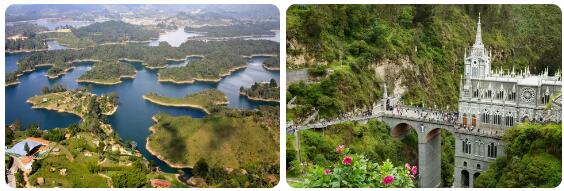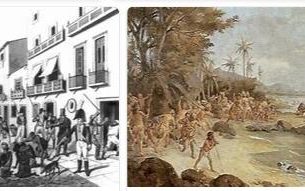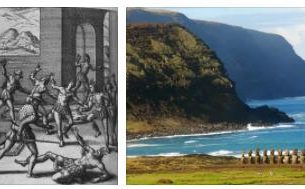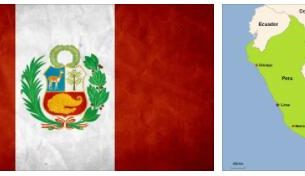The discoverer Columbus probably never entered the country named in his honor. Colombia is the fourth largest country in South America after Brazil, Argentina and Peru. It is about three times the size of Germany.
The Muisca, who lived in the Colombian area, were the most developed people in the region when the Spanish arrived. However, their culture cannot be compared with the high culture of the Inca or Maya. The economic basis of the Muisca was agriculture, especially the cultivation of potatoes and maize. Since the Spaniards suspected the legendary gold country “El Dorado” there, the natives fell victim to the conquests. The Muisca population is estimated to have been around one million in the 16th century. Today there are none left.
Although the economies of most South American countries are struggling with serious problems, the economy of Colombia is growing by around 4% annually. The rate of inflation and foreign debt are also quite low in comparison. Agriculture remains the dominant branch of the economy. 14% of the gross national income is generated there.
Unfortunately, this unique landscape is also one of the restless countries in the world. The Colombian Civil War, La Violencia, started in the 80s and continues to this day. So far it has claimed around 200,000 deaths. The country’s share of the international cocaine trade was estimated at around 90% in the 1990s. It is true that large cartels have been broken up. But the drug trade was taken over by smaller dealers. The influence of the drug mafia on the economy, sport, justice, police and politics should not be underestimated. In 1994, President Enesto Samper Pisano financed his election campaign with a donation of millions from the Cali cartel.
If you want to experience the magic of the violent and beautiful country in a literary way, you should read the novel “Hundred Years of Solitude” by the Colombian Nobel Prize winner Gabriel Garcia Márquez.
This novel, published in 1967, outlines an image of society that is essentially socially critical.
On July 2, 2008 Ingrid Betancourt (born 1961) was freed from the hands of the Farc rebels by the Colombian military. She was taken hostage by the Darc on February 23, 2002 on the occasion of an election trip as a presidential candidate. With her three US citizens and 11 other hostages were freed.
The FARC, which was originally a liberation army, has now degenerated into a criminal organization that makes its living through drugs and kidnapping
| Name of the country | República de Colombia (República de Colombia) |
| Form of government | Presidential Republic |
| Geographical location | Northwest South America; on the pacific ocean caribbean.The country borders with Venezuela, Brazil, Peru, Ecuador, and Panama. |
| National anthem | “Oh gloria Inmarcesible” |
| National holiday | July 20 (the country became independent on July 20, 1810) |
| Population | around 50 million (Credit: Countryaah: Colombia Population) |
| Ethnicities | Mestizos around 58%; Europeans 20%; Mulatto 14%; Africans 4%; other 4% |
| Religions | Catholics around 95%; other 5% |
| Languages | Spanish |
| Capital | Santa-Fe de Bogotá with around 7.5 million residents |
| Surface | 1,141,748 km² |
| Highest mountain | Pico Cristobal Colon with an altitude of 5,800 m |
| Longest river | Magdalena with a length of 1,550 km |
| Largest lake | Alberto Lleras dam with 13.44 km² |
| International license plate | CO |
| National currency | 1 peso (COB) = 100 centavos |
| Time difference to CET | – 6 h |
| International phone code | +57 |
| Mains voltage, frequency | 110 volts, 60 Hertz, an adapter for American flat pin plugs is necessary |
| Internet TLD (Top Level Domain) | .co |
Colombia: history
Prehistoric times
The oldest traces of human settlement in the country have been found in the highlands of Bogotá. Numerous independent civilizations lived there around 12,500 years ago. With the Tairona culture, the first advanced civilization developed in the Sierra Nevada de Santa Marta from the fifth century AD. The Muisaca culture emerged in the highlands of the Eastern Cordilleras in the eighth century. The cultures of the Tierradentes and San Agustin formed in the Central Cordillera.
Colonial period from 1499 to 1810
According to Abbreviationfinder website, 26 years after the first Spaniard Alonso de Ojeda (1470-1516) set foot on Colombian soil in 1499, the first permanent settlement in the Caribbean arose: Santa Marta. The famous Cartagena followed in 1533. The conqueror Gonzalo Jiménez de Quesada (1500 – 1579) advanced into the highlands of the Cordilleras from the north and subjugated the Muisca. Here he founded the capital Bogotá in 1538. Coming from the south of Ecuador, Sebastian de Benalcázar (1495 – 1551) conquered the south of Colombia. Coming from the west, the Ulm merchant reached Nikolaus Federmann(1506 – 1542) in 1539 Bogotá, to promote the colonization of the country on behalf of the Welser. The country’s wealth led to attacks by pirates under Sir Francis Drake on the fortified port city of Cartagena in 1544, 1560 and 1586. Nueva Granada the Spaniards called the area, which included the areas of today’s states of Colombia, Panama, Venezuela and Ecuador. The capital was Bogotá. Initially part of the Viceroyalty of Peru, in 1739 it became itself a Viceroyalty. 80 percent of the global gold production in the 17th century came from Colombia. The Indians worked in the gold mines, many of whom died of weakness and diseases brought in by the Europeans. After that, mostly African slaves took over the work that could be bought in the port of Cartagena. The city was attacked by an English armada of 186 warships in 1741 and defended by the Spanish troops under Don Blas de Lezo.
Struggle for independence from 1810-1819
The division of the insurgent “Juntas” made it easy for the Spanish troops to gain the upper hand during the War of Independence from 1810 to 1819. Only the intervention of the Venezuelan Simón de Bolívar(1783 – 1830) the Colombian rebels defeated the Spaniards in 1819. Now, together with the Venezuelans, they founded the Republic of Greater Colombia, to which Ecuador and Panama also belonged. After the Battle of Boyacá in 1821, the country was recognized internationally as independent. Bolívar was elected president in 1821. In 1830, after Bolívar’s death, this federation disintegrated because Bolívar’s attempts to win Peru and Bolivia had failed. Ecuador and Venezuela declared themselves independent. Panama and Colombia formed New Granada. The times of conflict between liberals and conservatives were similar to a civil war. The liberals wanted a federal state and were recruited from the middle classes of the trading cities. The Conservatives wanted a strong central state. They came from the class of the big landowners. In 1863 the Liberals pushed through a constitution and named the state:”United States of Colombia”. In 1886 the Conservatives enacted a constitution in which Colombia became a central state, the “Republic of Colombia”.
War of the Thousand Days and the Panama Conflict 1903
From 1899 to 1902 the Liberals attempted an uprising against the Conservative government in which 100,000 people died. The USA took advantage of this weakness of the country to assert their interests in Panama. The Colombian Congress had previously rejected the United States’ request to build a canal through the Isthmus of Panama. The United States then enforced Panama’s independence.
Great Depression, Civil War and National Front until 1974
Up until 1929 the economy flourished at unprecedented annual growth rates. After “Black Friday” in 1929 there was a crisis and in 1930 there was a change of government. The liberals brought land reform and industrialization to the country. From 1948 to 1957, political tensions erupted in a civil war that cost 200,000 lives. Peace was only created by the formation of the “National Front” in 1957. Liberal and conservative families came to an agreement and overthrew the dictator Gustavo Rojas Pinilla(1953-1957) and shared power. Every post in the state was filled equally or alternately according to a fixed key. The violence against small farmers and agricultural workers, which cannot be contained by the judiciary and the police, as well as internal unrest caused by the rigidity of the political system, made the left-wing guerrillas strong.
War of the guerrillas and the drug barons since 1974 until today
After the electoral victories of the liberals Alfonso López Michelsen (1974-1978) and César Turbay Ayala (1978-1982), corruption and mismanagement increased. The suppressed opposition and the political dependency on the police and the judiciary eroded the rule of law. Paramilitary groups are occupying parts of the country on behalf of the military and large landowners. The drug mafia, which was growing in economic power at the same time, saw itself threatened by the intervention of the USA in the local drug war since the early 1990s. At times, guerrillas and paramilitaries cooperatewith the drug cartels against government troops. Two thirds of the cocaine traded worldwide in 1995 was estimated to be from Colombian drug traffickers. Some areas are already completely dependent on cocaine exports economically. After the smashing of the large networks Cali Cartel and Medellín Cartel in the drug war, it is now smaller, decentralized networks that mostly sell drugs in the USA, the consumption of which is irrelevant in Colombia itself.



